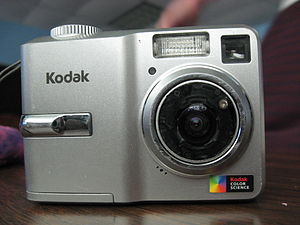Kodak has been struggling for years with the digital photo revolution. Despite making concerted and largely successful attempts to compete in the digital photography business — with digital cameras, online photo processing, and photo printers — Kodak has not been able to shed its old business quickly enough, causing it to burn through cash faster than it was coming in. Now, it has filed for bankruptcy in order to restructure its debt obligations. In a questionable move, Kodak is also looking to sell 1,100 digital imaging patents.
While the Kodak story is an excellent example of disruption — digital photography created a new value chain that allowed users to create the same output (photos) without Kodak or similar chemical film companies — there is also a lesson about scarcity and filtering, one immediately identifiable with photography but perhaps relevant to scholarly publishing.
The scarcity of traditional photography was created by the scarcity of chemicals and other precious raw materials. In addition, rolls of film were difficult to carry around and time-consuming to change, and film was susceptible to being ruined by unintentional exposure to normal light or other forms of radiation. All this made photography somewhat expensive and frustrating for the amateur — the barriers to entry were pretty high, and the barriers to heavy utilization mounted quickly. You kept a close eye on the number of photos left on a roll of film, worried about an unnecessary picture, and kept the kids away from the camera’s controls. The result was a relative scarcity of pictures, which translated into a preciousness of a sort — a good picture was treasured because it was a rarity inside scarcity.
While photography between 1950 and 2000 was more abundant than ever — and, if you were subjected to a family slideshow, seemingly interminable — it’s clear now that people were only wading into the world of photography when they were using chemical film. There was a scarcity of input created by the expenses involved with chemical film that led directly to a scarcity of output. Add onto this editing out the bad pictures, and the number of pictures produced and retained was modest.
The abundance of digital photography has resulted in the plethora of photography we have now. Flickr has more than 6 billion images in its archive. Our phones, computers, and social networks have dozens, if not hundreds, of photos on them. For the photographer, there is virtually no penalty to taking a dozen bad photos, to snapping silly pictures, to letting kids snap a hundred boring pictures. There are many new ways to share photos — text messaging, social media, email, remote printers, and photo frames. We are in a golden era for photography — or so you would think.
Unleashed by abundance, you would think that photos would be all around us. After all, sunsets are nearly always beautiful, kids almost predictably cute, and plays of light often fleeting. We carry good cameras with us everywhere now, in our phones at the very least. We can transmit photos thousands of miles in the blink of an eye. Yet, photos aren’t nearly as abundant as you might have predicted if the only rate-limiting factor was the scarcity created by chemical film, a scarcity digital photography has defeated.
Something else — something other than scarcity — is keeping the flood of pictures at bay.
There is a burden in photographic abundance, a pain we’ve all experienced. It’s the burden of whittling down the flood of photos into a coherent and efficient package. Because there isn’t a barrier at the input end anymore, we have to erect that barrier later, or the insanity of fifteen photos of the same mountain, the same animal, the same sunset, the same flower, or the same family smiling becomes clear. We only need one or two good ones. We don’t need them all. In fact, maybe we don’t need most of them.
Why not share all our photos? Not every picture of our cats is worth the label “lolcat.” Not every sunset is memorable or striking. There has to be a value in sharing, a value that bears on our reputations. Given this fact, suddenly we’re editors, and our time editing in the world of abundance has increased. Instead of flipping through a small batch of 24 pictures — pictures painstakingly created by negatives exposed onto photosensitive paper — and briefly editing out those with fingers over the lens or with somebody making rabbit ears, we have to scroll through a hundred or more photos and whittle down, delete-key after delete-key after delete-key.
We edit for our audiences, real or virtual. If we share too much, people shut us out. If we share well, people become fans. We’re not known for the quality of our photography as much as we’re known for the quality of our editing. Abundance has made us all publishers at some level, but that also means we’re all editors at some level, too.
The question of “publish first, then filter vs. filter first, then publish” is one scholarly publishing is facing consciously or unconsciously today. The Internet is removing the scarcity of print from our midst, and some publishing practices are removing other sources of scarcity — line editing, formatting, and so forth. Despite this, the value of editing for quality and relevance may only increase in the age of abundance. The filter may move from a physical limitation passively accepted to a conscious limitation actively imposed.
Recently, a study described in a headline on ArsTechnica as “the craziest f#@ing ‘theory of everything'” was published in a small open access journal entitled Life. Along with some support from the Case Western press office, this very questionable paper garnered more attention that it deserved, and not all of it negative, as bots and weak journalism perpetuated the story, often without question. As John Timmer, the reporter at ArsTechnica writes:
As far as I can determine, this paper doesn’t meet even minimal scientific standards. By giving it the credibility of having been peer-reviewed anyway, the reviewers arguably failed in their duty. . . . Ultimately, the job of editing and of peer review is to help ensure that only scientifically valid data and ideas end up in the literature.
As barriers to abundance stop enforcing scarcity, other pressures emerge — indexing and sorting from the technologists; reputation and identity for the sociologists; time and attention for the pragmatists; demand and value for the economists; sustainability and viability for the business people; relevance and quality for the editors. Throughout this transformation from physically enforced scarcity to self-enforced editing, we have to keep in mind that the picture of reality you present to others says as much about reality as it does about our choices in presenting it to others.
Discussion
3 Thoughts on "The Kodak Moment — Unleashed from Scarcity, Editing Becomes More Important"
Great post Kent. It reminds me of this recent article from Salon.
http://open.salon.com/blog/kerry_lauerman/2012/02/03/hit_record
They tried to increase readership by opening up the firehose of aggregation (quantity) and saw no positive effect. But when they instead published fewer articles that were longer and better (quality), they saw a large jump in readership:
We’ve tried to work longer on stories for greater impact, and publish fewer quick-takes that we know you can consume elsewhere. We’re actually publishing, on average, roughly one-third fewer posts on Salon than we were a year ago (from 848 to 572 in December; 943 to 602 in January). So: 33 percent fewer posts; 40 percent greater traffic.




